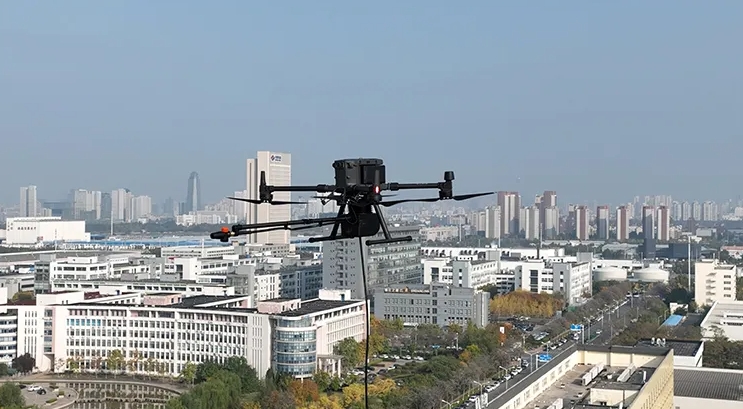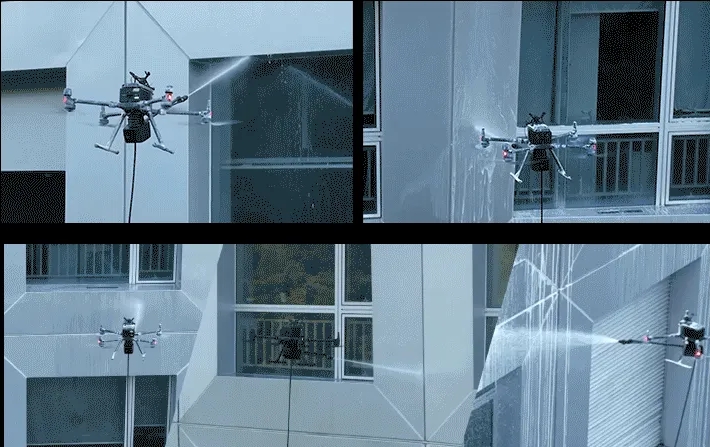Transforming Drones into “Spidermen” for High-Altitude Cleaning
As urbanization continues to accelerate, high-rise buildings are becoming a defining feature of cities across China. These towering structures not only shape the urban skyline but also play a crucial role in maintaining comfortable living and working environments.
The condition of building exteriors directly impacts property value, tenant satisfaction, and the overall image of the city. However, due to constant exposure to the elements, these facades accumulate dirt, stains, and mold, particularly after prolonged rainy seasons.

P3 (T50): Ultimate Tethered Cleaning System for DJI M300/350
Maintaining clean and well-preserved building exteriors has therefore become a vital task for property and urban managers. According to recent market research, the global facade cleaning market reached approximately $12 billion in 2023 and is projected to grow at an annual rate of 5%. In China alone, the market is expected to exceed ¥50 billion by 2025.
The Challenges of Traditional High-Rise Cleaning
Despite the demand for regular maintenance, traditional methods of high-rise exterior cleaning present significant drawbacks:
1. Manual Climbing: This high-risk, labor-intensive method relies on skilled workers operating at dangerous heights, leading to low efficiency and high costs.
2. Suspended Platforms or Lifts: While widely used, these methods are equipment-dependent, lack flexibility, and still pose safety risks.
3. Ground-Based Sprayers: Limited in reach, they often fail to clean higher sections of buildings effectively.
4. Fixed Rail Systems: Expensive and complex to install and maintain, these systems lack the flexibility to adapt to varying facade structures.
5. Mobile Robots: Though innovative, they are costly, difficult to operate, and often unsuitable for irregular building surfaces.
These challenges highlight the need for an efficient, flexible, and safer alternative to traditional cleaning methods.

Stable High-Altitude Operations
A Revolutionary Solution: The P3(T50) Aerial Flexible Tethered Cleaning System
To address these pain points, Foxtech introduces the P3(T50) Aerial Flexible Tethered Cleaning System, an advanced solution for high-altitude large-area cleaning. Designed to integrate with drones carrying 3–10 kg payloads, the P3(T50) system combines cutting-edge technology and smart engineering to deliver unparalleled cleaning efficiency and safety.
Key Features of the P3(T50) System:
-High-Pressure Cleaning: Capable of delivering up to 8 MPa of pressure, the system can efficiently clean glass, stone, aluminum, and other building surfaces.
-Tethered Water Supply: Supports uninterrupted operation by providing a continuous supply of water or cleaning solution, enabling extended work hours.
-Flexible Gimbal Design: Ensures multi-angle precision cleaning to address stubborn dirt on complex surfaces.
-Laser-Assisted Targeting: Real-time distance measurement guarantees safety and optimized cleaning performance.
-Remote Operation: Ground-based control eliminates the risks associated with high-altitude manual work.
-Broad Application: Suitable for cleaning skyscrapers, photovoltaic panels, insulators, towers, and other high-altitude installations.
Case Study: Shenzhen Landmark Cleaning Project
A recent project involving the P3(T50) system demonstrated its transformative impact. A 200-meter commercial tower in Shenzhen’s Nanshan district, a landmark in the bustling urban area, had accumulated significant mold and dirt due to extended rainy conditions. This compromised the building’s aesthetic appeal and threatened the durability of its facade materials.
Foxtech’s team conducted a three-day assessment, analyzing the extent of contamination and structural layout. Leveraging the P3(T50) Aerial Flexible Tethered Cleaning System, combined with a specialized cleaning solution for mold removal, Foxtech delivered a tailored cleaning operation.

Replaces Manual High-Altitude Operations
Results Achieved:
Enhanced Safety: By replacing manual labor with drone operations, the system eliminated safety risks for workers.
Increased Efficiency: The high-pressure cleaning system completed the task swiftly, minimizing disruption to building operations.
Outstanding Cleaning Results: The facade was restored to a spotless, like-new condition, enhancing the building’s image.
Cost Savings: The project required fewer labor hours and reduced operational expenses, increasing overall economic efficiency.
Material Longevity: Thorough cleaning preserved the facade’s materials, extending their lifespan and reducing future maintenance needs.
- Reinforcement Learning Enables Bipedal Robot to Conquer Challenging Terrain
- Drones for 3D Indoor Exploration-Cultural Relics Protection and Indoor Survey
- Industry Application: Intelligent Unmanned Operation Solutions for Lakes – Rapid Deployment for Continuous Protection
- High-Altitude Cleaning Case Introduction - Drone Spraying and Cleaning
- New Performance: SLAM Handheld Lidar Scanner + External Panoramic Camera New Combination

